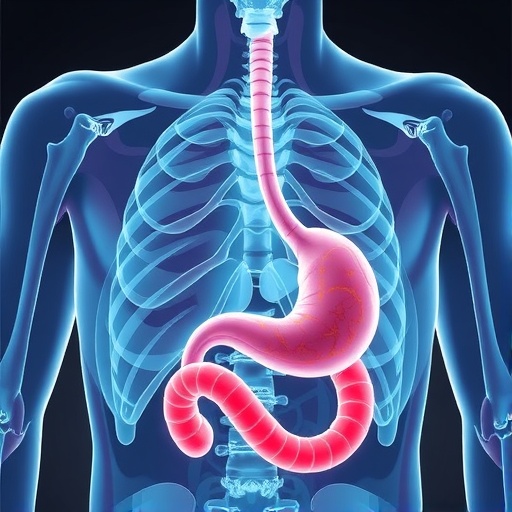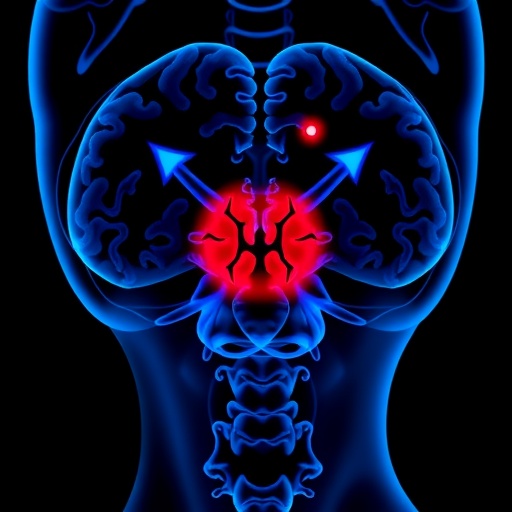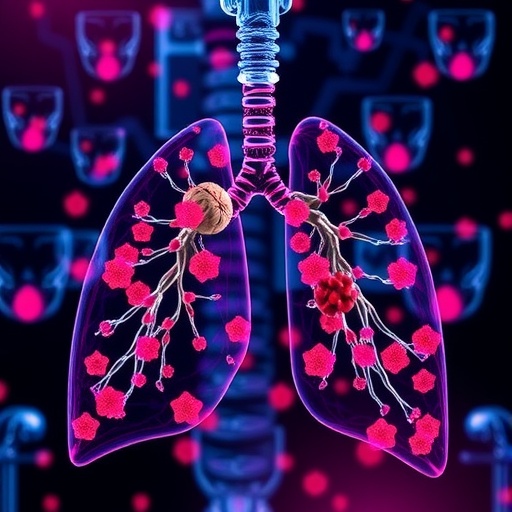In the relentless battle against gastric cancer, a newfound beacon of hope emerges in the form of the cachexia index (CXI), a promising biomarker designed to pinpoint the debilitating syndrome known as cancer cachexia. This condition, characterized by severe muscle wasting and systemic inflammation, has long plagued patients, drastically diminishing survival rates and quality of life. Recent groundbreaking research published in BMC Cancer illuminates the potential of CXI to revolutionize how clinicians assess and manage cachexia, offering a much-needed tool that is both accessible and reliable.
Gastric cancer remains one of the most formidable malignancies worldwide, often accompanied by cachexia—a complex metabolic syndrome marked not just by weight loss but by profound skeletal muscle degradation and deteriorating nutritional status. Cachexia severely compromises patient strength and resilience against cancer therapies, making its early and accurate detection pivotal. Traditional diagnostic criteria, while effective to a degree, often fall short in capturing the multifaceted nature of cachexia, emphasizing the urgent need for enhanced biomarkers.
The cachexia index cleverly integrates three critical biological indicators: skeletal muscle index (SMI), serum albumin levels, and the neutrophil–lymphocyte ratio (NLR). SMI serves as an imaging-derived proxy for muscle mass, serum albumin reflects nutritional and inflammatory status, while NLR is a recognized marker of systemic inflammation. By mathematically combining these variables into a composite index, CXI encapsulates the complex interplay of muscle depletion and inflammation inherent to cachexia.
.adsslot_nEtIO8edZG{ width:728px !important; height:90px !important; }
@media (max-width:1199px) { .adsslot_nEtIO8edZG{ width:468px !important; height:60px !important; } }
@media (max-width:767px) { .adsslot_nEtIO8edZG{ width:320px !important; height:50px !important; } }
ADVERTISEMENT
To rigorously validate the efficacy of this novel biomarker, researchers enrolled 431 patients diagnosed with gastric cancer, encompassing a broad demographic spectrum with a median age of 68 years. The study employed two widely accepted diagnostic frameworks for cachexia: the Asian Working Group for Cachexia (AWGC) criteria and Fearon’s criteria, enabling robust comparative analyses. Univariate and multivariate logistic regressions interrogated the relationship between CXI and cachexia, while Receiver Operating Characteristics (ROC) analysis measured its discriminative power.
Findings conveyed a compelling narrative: patients who met the AWGC-defined cachexia criteria exhibited significantly lower CXI values than their non-cachectic counterparts, a difference marked by a high degree of statistical significance. In contrast, the CXI showed no independent association with cachexia when diagnosed by Fearon’s criteria, highlighting potential nuances in the applicability of diagnostic frameworks. This distinction underscores the importance of precise criteria selection when employing biomarkers in clinical practice.
Notably, when dissecting the diagnostic accuracy through ROC curves, the CXI demonstrated considerable proficiency in identifying AWGC-defined cachexia, boasting area-under-the-curve (AUC) values of 0.752 for males and 0.717 for females. These values suggest that CXI possesses a meaningful capacity to discriminate between cachectic and non-cachectic patients, with sex-specific cut-off points calibrated at 74.46 for males and 43.80 for females. Such differentiation could empower tailored clinical interventions.
Beyond the realm of detection, the study delved into the impact of cachexia on health-related quality of life (HRQoL), an aspect often overshadowed by clinical measures. Patients exhibiting low CXI not only bore the brunt of physical deterioration but also endured markedly poorer quality of life across key domains. Multivariate analysis confirmed the independent association between reduced CXI and diminished HRQoL, flagging the index as a potential prognostic tool that extends beyond mere diagnosis to holistic patient assessment.
The ramifications of these results extend into clinical decision-making, where early identification of cachexia could prompt timely nutritional and therapeutic interventions aiming to stave off muscle depletion and reduce systemic inflammation. By harnessing routinely obtainable clinical data, CXI positions itself as a practical adjunct to existing assessment protocols, potentially streamlining workflows and facilitating personalized treatment.
Methodologically, the study’s synthesis of imaging parameters with serum biomarkers represents a significant advancement over traditional approaches that often rely on isolated measures. The inclusion of systemic inflammatory status through NLR is particularly salient, as inflammation is a central driver of cachexia progression and resistance to therapy. This multifactorial approach encapsulated in CXI acknowledges the complex biological underpinnings of cachexia, fostering a more nuanced understanding.
The study’s scale and comprehensive analytical approach lend credence to its findings, yet the authors prudently acknowledge the need for further validation across diverse populations and cancer types. Given that cachexia’s manifestations might vary geographically and ethnically, external validation remains a crucial step before widespread clinical adoption. Moreover, longitudinal studies could elucidate the CXI’s utility in monitoring therapeutic response and predicting long-term outcomes.
Intriguingly, the differential association of CXI with cachexia according to AWGC versus Fearon’s criteria invites deeper exploration. This discrepancy may arise from variations in the diagnostic parameters themselves or differential sensitivity to inflammatory and nutritional markers. Such insights could inform refinement of diagnostic standards, harmonizing them to better capture the clinical realities faced by patients.
From a translational perspective, CXI’s reliance on accessible clinical metrics advocates for its feasibility even in resource-constrained settings. Unlike more complex or costly assessments, such as advanced imaging or specialized laboratory tests, CXI leverages routinely collected data, potentially democratizing cachexia screening and management. This accessibility bolsters its appeal as a candidate biomarker in global oncology care.
Complementing its diagnostic advantage, the direct correlation of CXI with HRQoL spotlights its relevance for patient-centered care. As clinicians increasingly prioritize quality of life alongside survival, tools like CXI that inform both domains can facilitate holistic management strategies, including nutritional support, physical rehabilitation, and psychological interventions.
Importantly, the CXI could serve as a surrogate endpoint in clinical trials targeting cachexia, enabling objective measurement of intervention efficacy. Given the historical challenges in quantifying cachexia severity and response, this biomarker could accelerate therapeutic innovation, fostering the development of effective treatments.
In aggregate, this seminal study pioneers a pragmatic yet sophisticated biomarker that encapsulates the multifactorial pathology of cancer cachexia in gastric cancer. By blending muscle mass assessment, nutritional markers, and inflammatory indices, the cachexia index heralds a new era in oncologic supportive care—one where early detection, precise monitoring, and improved quality of life are tangible goals.
As the landscape of gastric cancer management evolves, integrating tools such as CXI into clinical algorithms promises to elevate patient outcomes, converting the shadow of cachexia from an insurmountable obstacle into a manageable clinical entity. Future research fueled by this innovative approach may unlock transformative strategies, reshaping the prognosis and daily experience of those afflicted by this formidable condition.
Subject of Research: Cachexia index (CXI) as a biomarker for cancer cachexia and health-related quality of life (HRQoL) in patients with gastric cancer.
Article Title: Cachexia index as a biomarker for cancer cachexia and quality of life in patients with gastric cancer.
Article References:
Huang, Y., Huang, Z., Hou, W. et al. Cachexia index as a biomarker for cancer cachexia and quality of life in patients with gastric cancer. BMC Cancer 25, 1293 (2025). https://doi.org/10.1186/s12885-025-14752-2
Image Credits: Scienmag.com
DOI: https://doi.org/10.1186/s12885-025-14752-2
Keywords: cachexia index, cancer cachexia, gastric cancer, skeletal muscle index, serum albumin, neutrophil–lymphocyte ratio, health-related quality of life, biomarker, systemic inflammation, prognostic tool
Tags: assessing cachexia in oncologycachexia index for gastric cancercancer cachexia biomarkerimproving patient quality of life in cancerinnovative biomarkers for cancer managementmuscle wasting in cancer patientsneutrophil-lymphocyte ratio significancenutritional status in cancer treatmentserum albumin levels and cancerskeletal muscle index importancesystemic inflammation in gastric cancertraditional diagnostic criteria for cachexia





